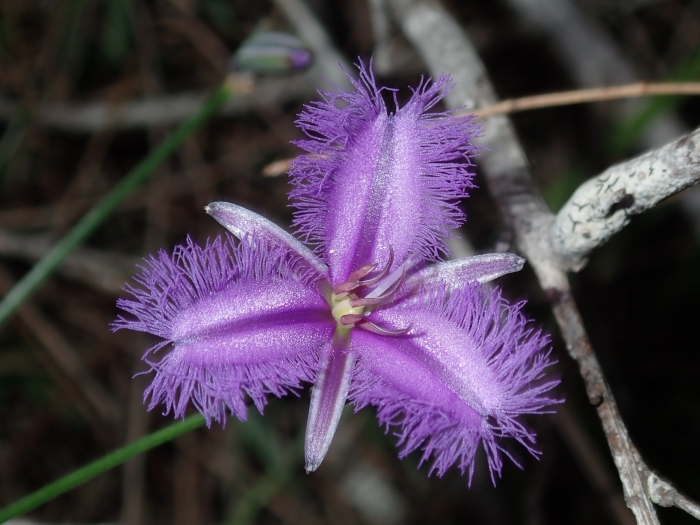Common Fringe-Lily
(Thysanotus tuberosus)
Common Fringe-Lily (Thysanotus tuberosus)
/
/

Thomas Mesaglio
CC BY 4.0
Image By:
Thomas Mesaglio
Recorded By:
Copyright:
CC BY 4.0
Copyright Notice:
Photo by: Thomas Mesaglio | License Type: CC BY 4.0 | License URL: http://creativecommons.org/licenses/by/4.0/ | Rights Holder: Thomas Mesaglio | Publisher: iNaturalist | Date Created: 2020-01-10T12:51:59-08:00 |






















Estimated Native Range
Summary
Thysanotus tuberosus, commonly known as the Common Fringe-lily, is a perennial herb that is endemic to a range of habitats across Australia, including open woodlands, forest edges, and heathlands. It typically grows to a height of 8-24 inches (20-60 cm). The Common Fringe-lily is notable for its distinctive purple, three-petaled flowers with fringed margins that appear from late winter to early summer (September to April in the Southern Hemisphere), offering a long flowering season. The flowers are quite showy and attract pollinators such as bees. The plant also produces small, globular, blue to purple berries after flowering.
The Common Fringe-lily is valued for its unique flowers and is used in cultivation for ornamental purposes, particularly in native plant gardens and as a border plant. It is relatively low-maintenance, requiring minimal water once established, and thrives in well-drained soils with a preference for sandy substrates. It can tolerate a range of light conditions, from full sun to part shade. While the roots are edible and were traditionally consumed by Indigenous Australians, they are not commonly used in modern horticulture. The plant can be propagated from seed or division of the tuberous roots. It is generally pest-free but can be susceptible to root rot in poorly drained soils.CC BY-SA 4.0
The Common Fringe-lily is valued for its unique flowers and is used in cultivation for ornamental purposes, particularly in native plant gardens and as a border plant. It is relatively low-maintenance, requiring minimal water once established, and thrives in well-drained soils with a preference for sandy substrates. It can tolerate a range of light conditions, from full sun to part shade. While the roots are edible and were traditionally consumed by Indigenous Australians, they are not commonly used in modern horticulture. The plant can be propagated from seed or division of the tuberous roots. It is generally pest-free but can be susceptible to root rot in poorly drained soils.CC BY-SA 4.0
Plant Description
- Plant Type: Herb
- Height: 0.5-1.5 feet
- Width: 0.5-1 feet
- Growth Rate: Moderate
- Flower Color: Purple
- Flowering Season: Spring
- Leaf Retention: Evergreen
Growth Requirements
- Sun: Full Sun, Part Shade
- Water: Medium
- Drainage: Medium, Fast
Common Uses
Bee Garden, Butterfly Garden, Low Maintenance, Potted Plant
Natural Habitat
Open woodlands, forest edges, and heathlands
Other Names
Common Names: Fringed Lily, Fringe Lily, Fringed-Violet, Common Fringe-lily
Scientific Names: , Thysanotus tuberosus, Chlamysporum tuberosum,
GBIF Accepted Name: